Tech Report
Specifying inline rotor/stator mixers
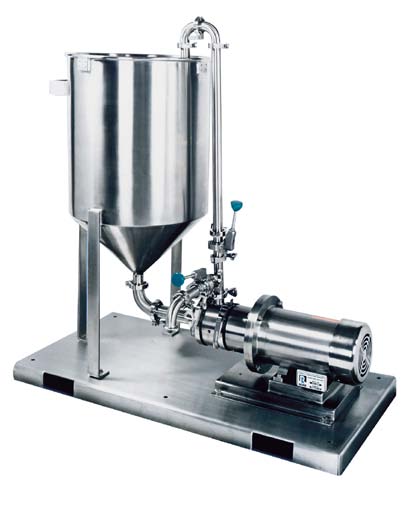
Technology Brief
This bulletin discusses some best practices and considerations in the selection and specification of inline rotor/stator mixers.
Continuous high shear mixing
Inline rotor/stator mixers are utilized throughout the process industries for high shear processing of flowable liquid applications. They can be operated in a truly continuous mode wherein feed streams are metered into the mixer, but more commonly, inline rotor/stator devices are set up for recirculation. With the starting liquid(s) charged into the recirculation tank, the mixer is turned on and subsequent raw material additions are done through the top of the vessel while the mixture recirculates.
An inline rotor/stator mixer behaves like a centrifugal pumping device. It is not self-priming and thus requires static pressure (gravity-feeding) or positive pressure (pump-feeding) to introduce materials into the mix chamber. Because an inline mixer is typically positioned on the floor or on a platform below the liquid level, gravity usually feeds the product into the mix chamber. Here the product is subjected to high shear as the rotor turns at tip speeds ranging from 3,000 to 4,000 ft/min and expels the mixture out of the chamber through the holes of the stationary stator. Depending on the rotor/stator geometry, an inline mixer can handle viscosities up to 10,000-20,000 cP without external pumping assistance. With an auxiliary pump, it can process much more viscous materials.
Mixer selection and specification considerations
- Check that contact parts are made of materials compatible with all the products you are looking to run through the mixer. Ask about surface treatment options if your application is abrasive to some degree or contains harsh chemicals.
- A mechanical seal on the rotating shaft is used to isolate the mix chamber from the environment. Single mechanical seals are product-lubricated. If the process fluid has poor lubricating quality or if the process requires prolonged heating of the mixer to 300°F or higher, double mechanical seals are recommended as these are lubricated by an external fluid and offer better temperature control than single seals. Confirm that the lubricant and elastomers on the seal are compatible with your product.
- Testing is very useful in determining actual flow rates and approximating how many passes it takes to achieve the finished product. Based on these data, you can then set an acceptable cycle time and select the suitable mixer size.
- If using a large recirculation tank (>500 gallons), plan on using a tank-mounted agitator to help promote bulk flow within the vessel. Gentle blending devices such as slow speed propellers, anchor agitators and turbines normally suffice.
- For high solids applications as well as thickened solutions involving hard-to-disperse powders (gums, starches, fumed silica, thickeners, etc.), consider an inline rotor/stator mixer equipped for high speed powder induction. Instead of being charged on top of the recirculation vessel where they can float and resist complete wet-out, solids are introduced directly into the high shear zone of the mix chamber. This is accomplished via a powerful negative pressure generated by the ported rotor/stator assembly.
- If simulation trials on a regular rotor/stator reveal that it cannot reach a desired particle or droplet size despite multiple recirculations, try an ultra-high shear mixer. New designs with rotors that run up to 11,000 ft/min are available.
Ross Inline Rotor/Stator Mixers
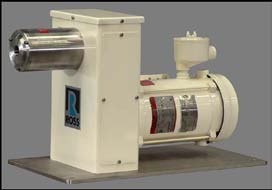
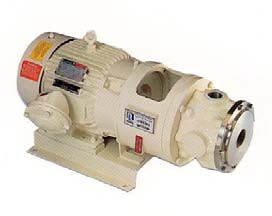
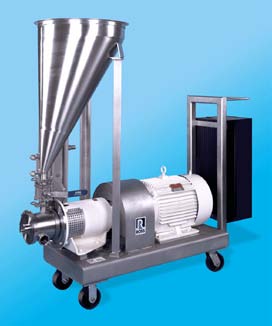
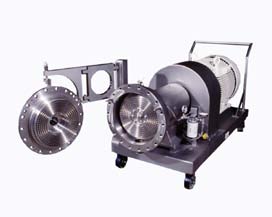
Sample Application: Beverage Emulsions
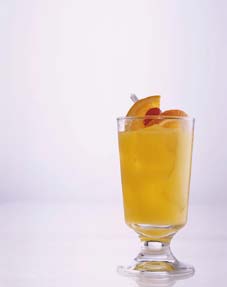
A prominent flavors company visited the Ross Test & Development Center to run trials on a 1 HP laboratory inline rotor/stator mixer. The simulation experiments demonstrated that this type of mixer is able to produce average droplet sizes in the submicron range for a variety of emulsions used in beverage flavorings. In addition to flow rate and particle size data collected during the test, percent transmittance was also determined for all samples which further helped the process engineers choose mixer features with confidence. For this application, a 30HP production unit was selected to keep the processing time of a 3,000kg-batch under 2 hours.